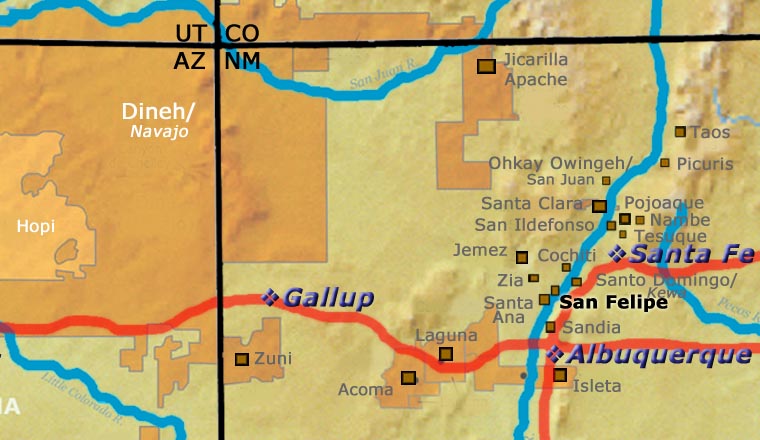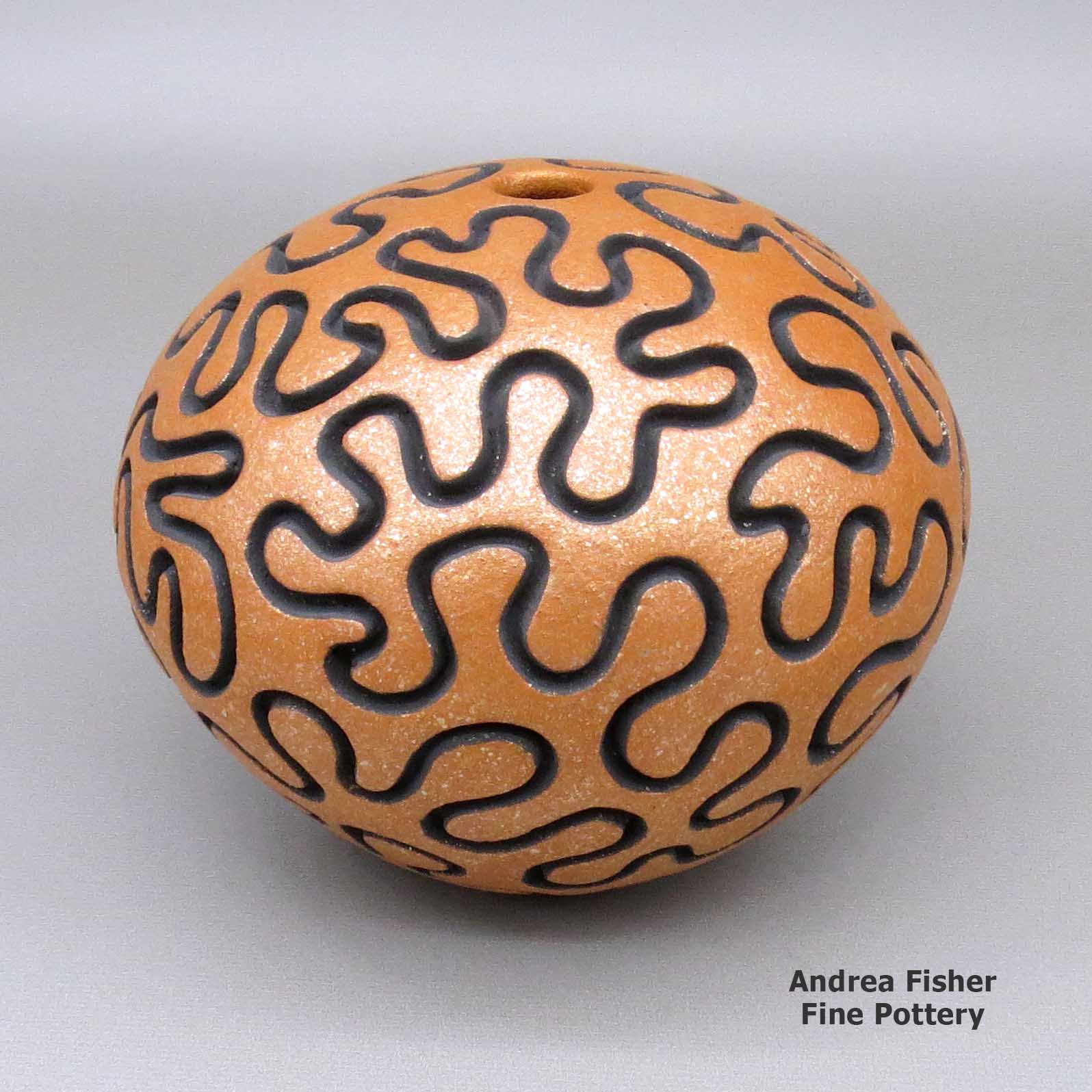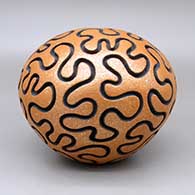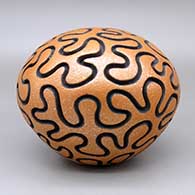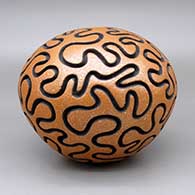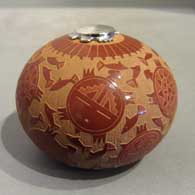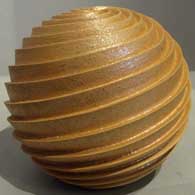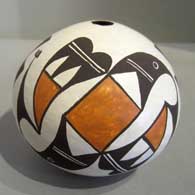
Hubert Candelario
San Felipe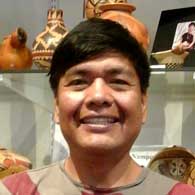
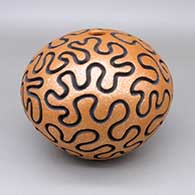
Hubert Candelario (Butterfly) was born into San Felipe Pueblo in 1965. He's been actively making pottery since 1987.
Historically, San Felipe was not an active pottery center. San Felipe residents obtained their pottery in trade from neighbors, most often from Zia Pueblo.
Hubert earned an associate's degree in architectural design and drafting. That has fostered his appreciation for structure and pure architectural form. He credits Maria Martinez as being a major influence in his pottery career. He also says Santa Clara potter Nancy Youngblood has had a direct impact on his work with her swirl carved melon pots.
Made the traditional way, his early works were polished redware. Today he is famous for his precisely carved puzzle pots, melon jars and pots perforated with circular or hexagonal holes.
The structure of his pottery is formed with a red clay local to San Felipe. He completes the concept with layers of orange micaceous slip, burnished after each layer, to create his fabulous color and texture. The micaceous clay he gets from Nambe and Picuris Pueblos. He fires his pottery in a kiln to achieve an even color, free of fire clouds.
Hubert has earned numerous awards including more than one First Place ribbon at the Santa Fe Indian Market. His work was included in the 2002 exhibit and catalog Changing Hands: Art without Reservation at the American Craft Museum in New York City. One of his large swirl-cut melon jars was also selected for the permanent collection at the Denver Art Museum.
He signs his work: "Hubert Candelario, San Felipe Pueblo", followed by the date the piece was made.
Some Exhibits that featured pieces by Hubert
- Breaking the Mold. Denver Art Museum. October 7, 2006 - August 19, 2007
- Breaking the Surface: Carved Pottery Techniques and Designs. Heard Museum. Phoenix, Arizona. October 2004 - October 2005
- Indian Market: New Directions in Southwestern Native American Pottery. Peabody Essex Museum. Salem, Massachusetts. November 16, 2001 - March 17, 2002
- Exhibition of New Works. Gallery 10. Scottsdale, Arizona. March 28, 1996
Some Awards Earned by Hubert
- 2023 Santa Fe Indian Market, Classification II-E, Category 905, Miscellaneous, First Place
- 2020 Heard Museum Guild Indian Fair & Market, Classification II - Pottery: Innovation Award for Pottery. Awarded for artwork: Oval Pot with Hole with Lid with Holes
- 2019 Santa Fe Indian Market, Classification II-E, Category 905 - Contemporary pottery, any form or design, using commercial clays/glazes, all firing techniques - Miscellaneous: First Place and Second Place
- 2019 Heard Museum Guild Indian Fair & Market, Classification II-G - Pottery miniatures not to exceed three (3) inches at its greatest dimension: Second Place. Awarded for artwork: "Mini or Small Pot Flowing"
- 2019 Heard Museum Guild Indian Fair & Market: Judge's Award - Jeremy Frey. Awarded for artwork: "Mica 9 Dragonfly Pot with Holes"
- 2018 Santa Fe Indian Market, Classification II - Pottery, Division F - Miniature pots, individual pieces under 3 inches in any dimension: Best of Division
- 2018 Santa Fe Indian Market, Classification II-F - Miniature pots, individual pieces under 3 inches in any dimension, Category 1002 - Contemporary: First Place
- 2018 Heard Museum Guild Indian Fair & Market, Classification II - Pottery, Division G - Pottery miniatures not to exceed three (3) inches at its greatest dimension: Fist Place. Awarded for artwork: "Starmelon Mica Mini"
- 2017 Santa Fe Indian Market, Classification II - Pottery, Division E - Contemporary Pottery, any form or design, using commercial clays/glazes, all firing techniques, Category 905 - Miscellaneous: Honorable Mention
- 2017 Heard Museum Guild Indian Fair & Market. Classification II Pottery, Division E - Any Design or Form with Native Materials, Kiln Fired Pottery: Second Place. Awarded for Artwork: Mica Spirit Bowl
- 2004 Santa Fe Indian Market. Southwestern Association for Indian Arts, Classification II - Pottery, Division G - Non-traditional pottery, using traditional materials and techniques, any form or design, Category 1403 - Ribbed jars, wedding jars, vases and bowls, First Place
- 2004 Santa Fe Indian Market. Classification II - Pottery, Division G - Non-traditional pottery, using traditional materials and techniques, any form or design, Category 1411 - Miscellaneous: First Place
- 2004 Santa Fe Indian Market. Classification II - Pottery, Division K - Pottery miniatures, 3" or less in height or diameter, Category 1704 - Non-traditional forms or designs: First Place
- 2000 Santa Fe Indian Market. Classification II - Pottery, Division H - Non-traditional pottery, Category 1505 -Jars and vessels: Third Place
- 1997 Santa Fe Indian Market. Classification II - Pottery, Division H - non-traditional, Category 1505 - Jars: First Place
- 1997 Santa Fe Indian Market. Classification II - Pottery, Division H - Non-traditional, Category 1507 - Bowls: Third Place
- 1995 Santa Fe Indian Market. Southwestern Association for Indian Arts, Classification II - Pottery, Division H - Non-traditional, Category 1603 - Jars and vases: First Place
- 1995 Santa Fe Indian Market. Southwestern Association for Indian Arts, Classification II - Pottery, Division H - Non-traditional, Category 1604 - Bowls: Third Place
100 West San Francisco Street, Santa Fe, New Mexico 87501
(505) 986-1234 - www.andreafisherpottery.com - All Rights Reserved

San Felipe Pueblo
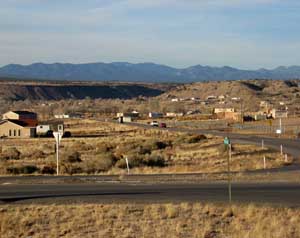
San Felipe Pueblo today
During the great migrations from the Four Corners area to the Rio Grande Pueblos the people of Cochiti and San Felipe were one. On arriving near the Rio Grande they settled in the area now known as Bandelier National Monument, taking advantage of a landscape that made it easy to construct dwellings. However, over time that area got too dry, too, and the people decided to move closer to the large river. Disagreements over where to settle split the people into what is now the Cochiti and San Felipe tribes.
When Francisco de Coronado arrived in 1540, there were two San Felipe villages, one on each side of the Rio Grande. The main villages were comprised of large two-and-three-story structures plus a couple hundred outlying dwellings. The Spanish built their first mission church next to the east village around 1600.

Part of the San Felipe ancestral home
The people of San Felipe participated in the Pueblo Revolt of 1680 but killed no Spaniards or any priests. Governor Otermin returned with troops in 1681 and found San Felipe abandoned as the people had hidden themselves atop nearby Horn Mesa. The Spaniards looted and burned the pueblo before returning to Mexico. When Don Diego de Vargas came back in 1692, the people chose to surrender and be baptised rather than fight. To test the peace they first settled atop nearby Santa Ana Mesa. A few years later they descended into the Rio Grande Valley and founded today's pueblo.
San Felipe has always had more arable land than most of the other pueblos and is still known for its agricultural products, although most people commute to work off-pueblo. The long-held isolationism of the San Felipe people has contributed to the loss of many traditional activities, including the making of pottery. Most San Felipe potters active today either learned the art on their own or learned from artisans at other pueblos. The revival of San Felipe pottery tradition is further complicated by the fact so few people remember where good clay might be found on the pueblo lands.
100 West San Francisco Street, Santa Fe, New Mexico 87501
(505) 986-1234 - www.andreafisherpottery.com - All Rights Reserved

San Felipe
$ 2200
gmsf4a129
Micaceous gold-on-black seed pot with a carved organic design
5.75 in L by 5.75 in W by 4.75 in H
Condition: Very good, rubbing on bottom
Signature: Hubert Candelario San Felipe NM
Date Created: 2002
100 West San Francisco Street, Santa Fe, New Mexico 87501
(505) 986-1234 - www.andreafisherpottery.com - All Rights Reserved

Seed Pots
Acoma, Hopi, Isleta, Jemez, Laguna, San Felipe, San Ildefonso, San Juan, Santa Clara
Acoma Pueblo
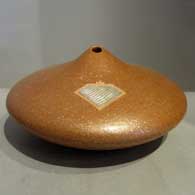
Hopi
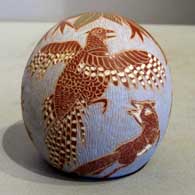
Santa Clara Pueblo
It was a matter of survival to the ancient Native American people that seeds be stored properly until the next planting season. Small, hollow pots were made to ensure that the precious seeds would be kept safe from moisture, light and rodents. After seeds were put into the pot, the small hole in the pot was plugged. The following spring the plug was removed and the seeds were shaken from the pot directly onto the planting area.
Today, seed pots are no longer necessary due to readily available seeds from commercial suppliers. However, seed pots continue to be made as beautiful, decorative works of art. The sizes and shapes of seed pots have evolved and vary greatly, depending on the vision of Clay Mother as seen through the artist. The decorations vary, too, from simple white seed pots with raised relief to multi-colored painted, raised relief and sgraffito designs, sometimes with inlaid gemstones and silver lids.
100 West San Francisco Street, Santa Fe, New Mexico 87501
(505) 986-1234 - www.andreafisherpottery.com - All Rights Reserved
